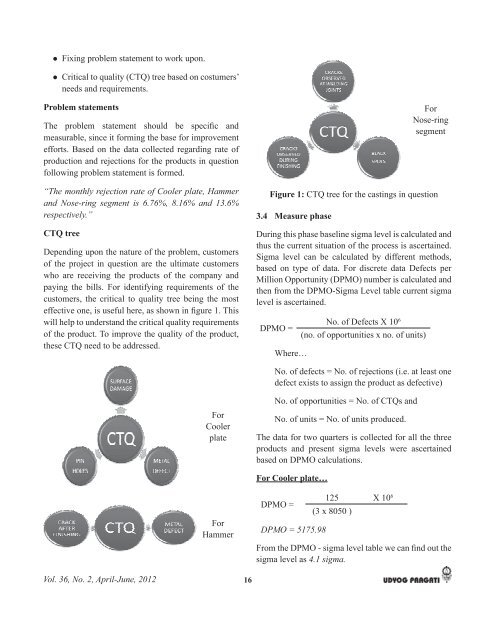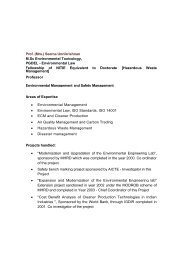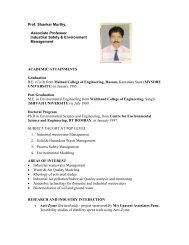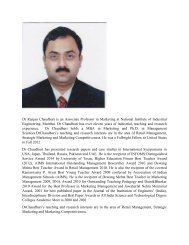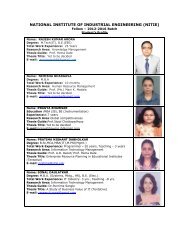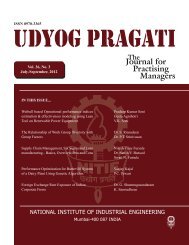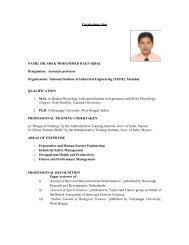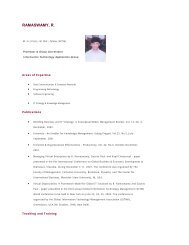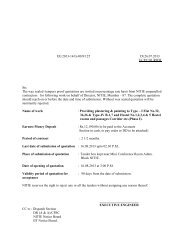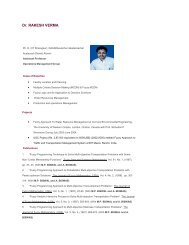Apr-Jun.12 - the Nitie
Apr-Jun.12 - the Nitie
Apr-Jun.12 - the Nitie
You also want an ePaper? Increase the reach of your titles
YUMPU automatically turns print PDFs into web optimized ePapers that Google loves.
Fixing problem statement to work upon.<br />
Critical to quality (CTQ) tree based on costumers’<br />
needs and requirements.<br />
Problem statements<br />
<br />
measurable, since it forming <strong>the</strong> base for improvement<br />
efforts. Based on <strong>the</strong> data collected regarding rate of<br />
production and rejections for <strong>the</strong> products in question<br />
following problem statement is formed.<br />
<br />
<br />
<br />
CTQ tree<br />
Depending upon <strong>the</strong> nature of <strong>the</strong> problem, customers<br />
of <strong>the</strong> project in question are <strong>the</strong> ultimate customers<br />
who are receiving <strong>the</strong> products of <strong>the</strong> company and<br />
paying <strong>the</strong> bills. For identifying requirements of <strong>the</strong><br />
customers, <strong>the</strong> critical to quality tree being <strong>the</strong> most<br />
<br />
will help to understand <strong>the</strong> critical quality requirements<br />
of <strong>the</strong> product. To improve <strong>the</strong> quality of <strong>the</strong> product,<br />
<strong>the</strong>se CTQ need to be addressed.<br />
For<br />
Nose-ring<br />
segment<br />
Figure 1: CTQ tree for <strong>the</strong> castings in question<br />
3.4 Measure phase<br />
During this phase baseline sigma level is calculated and<br />
thus <strong>the</strong> current situation of <strong>the</strong> process is ascertained.<br />
Sigma level can be calculated by different methods,<br />
based on type of data. For discrete data Defects per<br />
Million Opportunity (DPMO) number is calculated and<br />
<strong>the</strong>n from <strong>the</strong> DPMO-Sigma Level table current sigma<br />
level is ascertained.<br />
DPMO =<br />
Where…<br />
No. of Defects X 10 6<br />
(no. of opportunities x no. of units)<br />
No. of defects = No. of rejections (i.e. at least one<br />
defect exists to assign <strong>the</strong> product as defective)<br />
For<br />
Cooler<br />
plate<br />
No. of opportunities = No. of CTQs and<br />
No. of units = No. of units produced.<br />
The data for two quarters is collected for all <strong>the</strong> three<br />
products and present sigma levels were ascertained<br />
based on DPMO calculations.<br />
For Cooler plate…<br />
For<br />
Hammer<br />
DPMO =<br />
<br />
125 X 10 6<br />
(3 x 8050 )<br />
<br />
sigma level as <br />
Vol. 36, No. 2, <strong>Apr</strong>il-June, 2012<br />
16


